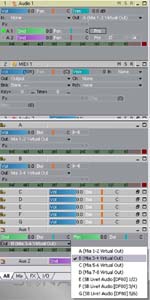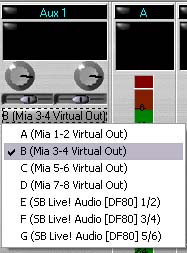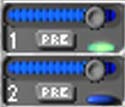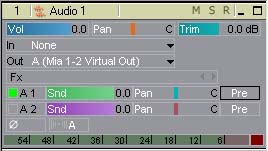Integrating hardware with SONAR 2.0
Last updated on 3/31/2016Have you ever wondered how to use hardware effects with SONAR 2.0? Do you have a multiple I/O card and want to be able to create multiple headphone mixes for individual musicians? Would you like to run an electric piano or other samples through one of your old stomp boxes? If you answered yes to any of the above, this tech tip is for you.
Traditional recording studios have always had a wide variety of routing and mixing options. Luckily, SONAR 2.0 can match and even exceed a hardware based studio in terms of flexibility and versatility.
When you run SONAR 2.0 for the first time or you profile your audio hardware, a default set of virtual main buses (main outputs) is created, one for each hardware output. Each virtual main bus contains a left and right channel, but only one volume control—you balance the two channels with the balance slider that is on each virtual main bus. SONAR 2.0 gives you the option to create extra virtual main buses—up to 64 in total. You can control the volume and effects separately for each set of virtual mains, similar to the sub-groups on a hardware mixer, but with each virtual main bus controlling its own final output.
First let's begin with a review of the basics of virtual mains. For those more advanced users, virtual mains are basically the software equivalent of subgroups, but with a bit more flexibility.
The basic procedures you should know about virtual main buses are:
- Creating virtual main buses
- Assigning tracks to virtual main buses
- Assigning Virtual Mains to a hardware output
To Create Virtual Main Buses
1. Open the Audio Options dialog box by using the Options-Audio command.
2. On the General tab, in the Number of Virtual Mains field, use the + or - spin buttons (or enter a number between 1-64) to set the number of virtual main buses that you want.
3. Click OK and restart SONAR.
To Assign Tracks to a Virtual Main Bus
1. In the Track or Console view, set an audio track's output to one of the virtual main buses.
2. Repeat step 1 for each track you want to include in that sub-group.
To Assign a Virtual Main to a hardware output
1. Open the Virtual Mains Pane on the lower left of the Track View.
2. Expand a virtual main or select the I/O tab so that the Out parameter is visible.
3. Click on Out and select one of your sound cards' physical outputs
After you finish assigning tracks to a virtual main bus, you can adjust the final output volume of all the tracks in that sub-group with the volume fader on the virtual main bus. You can also add master effects to the sub-group at the virtual main bus.
Below is a basic diagram of the signal flow in SONAR 2.0.
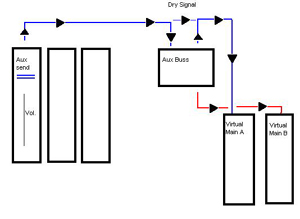
Incorporating hardware effects into SONAR 2 projects.
Please note: multiple I/O cards work best for this. A good example of a multiple I/O card would be a Midiman Delta 1010, an Echo Layla 24, a MOTU 2408 , or an Aardvark Q10.
1. Assuming you are using outputs 1 and 2 as the main outputs from your soundcard, take outputs 3 and 4 and run them into the stereo inputs on your effects unit.

2. Take the effect units stereo outputs and plug them into inputs 3 and 4 in your soundcard.
3. Set the Virtual Main B output to use outputs 3 and 4 on your soundcard.
|
|
|
4. Now set the output from an AUX bus to Virtual Main B. Be sure the Aux is enabled in your audio track that you want to process and you have 'PRE' selected in the PRE/POST option. When this is set to PRE, your audio signal is sent directly to and AUX bus, bypassing the channel or tracks volume control. In Post mode, the Volume control is engaged before your signal is sent to an Aux Bus, giving an undesirable result for this particular setup.
|
|
|
5. You can now bring down your processed tracks volume to adjust the dry or un-effected signal. Use the Send control to adjust the volume that is sent out to your effects unit.
6. To actually hear the returned effected signal, you will need to adjust the control panel for your particular sound card to monitor all returning inputs. For example, The Delta Control Panel, The Echo Console, The Direct Pro Control Panel, or the MOTU PCI-324 Console. You can record the results of your effected signal onto an audio track for mix-down. Simply select the input source of an audio track to match the audio input which has your effect returned.
|
|
|
You can use this approach for any type of effect unit, a standard rack mount compressor, a floor based distortion unit (stomp box), wah-wah pedal, reverb unit, or even and old tube mic preamp to warm up your tracks.
Variation on a theme.
As mentioned earlier in the article, you can use this same approach for creating multiple mixes for separate headphones, a separate record mix (if you are going to a different medium, like DAT for example), and a control room mix. You can plug headphones, a DAT recorders recording input, or a set of powered monitors directly into one of the outputs pairs offered by a multiple I/O card.
Note* It is important to mention that A/D and D/A converters have an inherent amount of latency in them, regardless of which sound card you use. On average, you will experience about 1.5 ms of latency when running audio in or out of the computer. Therefore, processing tracks externally and rerecording them will generally yield a track that is about 3ms behind the original. You can nudge the track by using the Snap To Grid with the resolution set to X samples.

